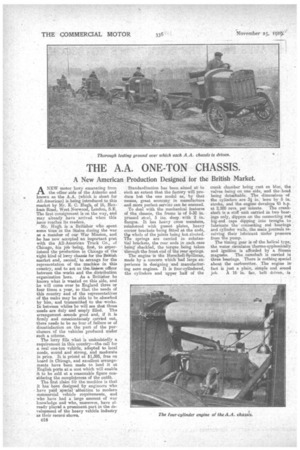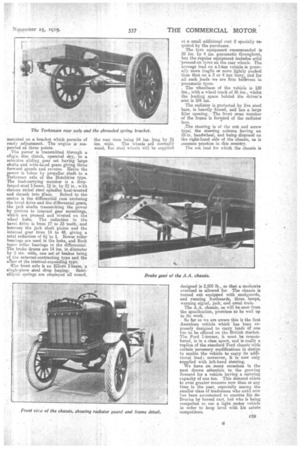THE A.A. ONE-TON CHASSIS.
Page 10

Page 11

If you've noticed an error in this article please click here to report it so we can fix it.
A New American Production Designed for the British Market.
A NEW motor lorry emanating from the other side of the Atlantic and known as the A.A. (which is short for All-American) is being introduced to this market by Mr. E. C. Hugh, of 16, Rexham Road, West Norwood, London, S.E. The first consignment is on the way, and may already have arrived when this issue reaches its readers.
Mr. Hugh is a Britisher who spent some time in the States during the war as a member of our War Mission, and he has now accepted an important post with the AU-American Truck Co., of Chicago, his job being, first, to superintend the production in Chicago of the right kind of lorry chassis for the British market and, second; to arrange for the representation of the machine in this country, and to act, as the. liaison officer between the works and the distribution organization here. As a Britisher he knows what is wanted on this side, and he will come over to England three or four times a year, So that the needs of this country and of the representatives of the make may be able to he absorbed by him, and transmitted to the works. In between whiles he will see that those needs are duly mid amply filled. The arrangement pounds good and, if it is firmly and conscientiously carried out, there needs to be no fear of failure or of dissatisfaction on the part of the purchasers of the vehicles produced under such a scheme.
The lorry fills what is undoubtedly a requirement in this country—the call for a, real one-ton vehicle, adapted to local needs, sound and strong, and moderate in price. It is priced at $1,395, free on hoard in Chicago, and excellent arrangements have been made to land it at English ports at a cost which will enable it to be sold at a reasonable figure considering the completeness of the outfit. The first claim fOr the machine is that it has been designed by engineers wbo have paid special attention to modern commercial vehicle requirements, and who have had a large amount of war knowledge and who, moreover, have already played a prominent part in the development of the heavy vehicle industry as their record shows.
Clff Standardization has been aimed at to eiich an extent that the factory will produce but the one model as, by that means, great economy in manufacture and more perfect service can be ensured. To deal with the mechanical features of the chassis, the frame is of 5-32 in. pressed steel, 5 ins, deep with 2 in. flanges. It has heavy cross members, reinforced with gusset plates, heavy corner brackets being fitted at the ends, thp whole of the joints being hot riveted. The springs are carried in substantial brackets, the rear ends in each case being shackled, the torque being taken through the front end of the rear springs. The engine is the lierschell-Spillman, made by a concern which bad large experience in designing and manufacturing aero engines. It is four-cylindered, the cylinders and upper half of the
crank chamber being cast en bloc, the valves being on one side, and the head being detachable. The dimensions of the cylinders are 34 in. here by 5 in. stroke, and the engine develops 43 h.p. at 2,200 revs, per minute. The crankshaft is a stiff unit carried in two hearings only, dippers on the connecting red big-end caps dipping into troughs to lubricate the connecting rod bearings and cylinder walls, the main journals receiving their lubricant Under pressure from the pump.
The timing gear is of the helical type, the water circulates thermo-syphonically and ignition is afforded by a Simms magneto. The camshaft is carried in three bearings. There is nothing special about the carburetter. The engine in' fact is just a plain, simple and sound job. A 16 in. fan, belt driven, is mounted .on a bracket which permits. of ready adjustment. The engine is suspended at three points.
.The power' is transmitted through a shigle disc clutch, operated dry, to a selective sliding gear set having largo shafts and wide-faced gears giving three forward speeds and reverse. Hence the power is taken by propeller shaft to a 1!orbensen axle of the Hotchkiss type. The load-carrying member is a. dropforged steel I-beam, 14 in. by 2g in., with chrome nickel steel spindles heat-treated and shrunk into qace. Bolted to the centre is the differential case enclosing the bevel drive and the differential gears, the jack shafts transmitting the power by pinions to internal gear mountings, which are pressed and riveted on the wheel hulas. The reduction in the bevel drive is from 17 to 33 teeth, and between the jack shaft pinion and the internal gear from 14 to 48, giving a . total reduction of 61.`tu 1. Bower roller bearings are used in the hubs, and Bock taper roller bearings in the differential. The brake drums are 14 ins, in diameter by 2 ins, wide, one set of brakes being t't the external-contracting type and the odier of the internal-expancLing type, '11'he front axle is an Elliott I-beam, a single-piece steel drop forging. Semielliptic springs are employed all round,
the rear ones being 54 ins. long by 21 Me, wide. The wheels era normally wood, tut steel wheels will be supplied at a small additional cost if specially required by the purchaser.
The tyre equipment recommended is 32 ins. by 4 ins, pneumatic throughout, but the regular equipment includes solid -preased-on tyres on the rear wheels. The average lead on a iston vehicle is generally more fragile or more lightly packed than that on a 3 or 4 ton lorrys and for all such loads we are firm believers in pneumatic tyres.
. The wheelbase of the vehicle is 130 ins., with a. wheel track of 56 ins., whilst the loading space behind the driver's scat is 104 ins.
The radiator is protected by five steel lsara, is heavily finned, and has a large filler opening. • The, front cross member of the frame is forvlard of the radiator face.
The steering is of the nut and screw type; the steering column having an 18-in, hantlwheel, and being disposed on the right-hand side of the chassis, as is common psactise in this country.
The net load for which the chassis in designed is 2,500 lb., so that a moderate overload is allowed for. The chassis is turned out equipped with mudguards, and running footboards, three, lamps, warning signal, jack, and usual tools. The A.A. chassis, as will be seen from the specification, promises to be well up to its work.
So far as we are aware this is the first American vehicle which has been expressly designed to carry loads of one ton to. he offered on the British Market. The Ford 1-tenner, it must be remembered, is in a claw apart, and is really a replica of the standard Ford chassis with certain necessary modifications in design to enable the vehicle to carry its additional load ; sncrreovers it is now only supplied with left-band steering. We have on many occasions in the past drawn attention to the growing demand for a vehicle having a carrying capacity of one ton. This demand exists in even greater measure now than at any time in the past, especially among the smaller class of tradesman who until now has been accustomed to execute his deliveries by horsed cart, but who is being compelled to use a light motor vehicle in order to keep level with his astute competitors.








































